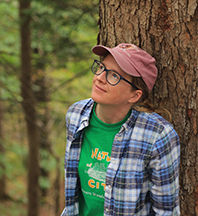Week of June 2, 2024 – June 8, 2024

by Anna Stunkel, Environmental Educator
On a warm late spring night just before a torrential downpour, some of our staff recently went on an adventure to explore the shores of Phillips’ Pond. I arrived a bit after Tom and Katie, and immediately heard a screech-owl tremoloing by the lower parking lot. As I walked up the hill, crickets chirped and a couple of fireflies were glowing above the meadow. A tiny moth perched atop a grass stalk, red eyes glowing in the light of my headlamp. Nearing the pond, the resounding trills, peeps, and banjo twangs of Gray Treefrogs, Spring Peepers, and Green Frogs filled the air. All of these amphibians call at night in order to attract a mate, fertilize eggs, and then hop into the forest or pond for the summer.
Over near the bird blind, Tom and Katie showed me a tiny peeper nestled in a blackberry bush. Although small, his incredibly loud call rang in our ears thanks to the vocal sac that amplified his peeps. The expanding sac makes this singing treefrog look a bit like he’s blowing a bubblegum bubble. Their calls are so loud that if you’re only 50 centimeters from a singing peeper, it’s as loud as a motorcycle would be from 25 feet away! That’s about 90 decibels of “peep!”
As we continued strolling around the pond, we looked closely among the vegetation for more frogs. Treefrogs can be difficult to spot even when you’re very close to them, since different calls are echoing all around in many directions. It’s kind of like trying to find a friend who’s calling your name across a crowded and chatty room. We finally came across several well-camouflaged, bumpy-skinned little Gray Treefrogs. Their gray coloration is blotched with patches that look like cracks in tree bark. They often have tinges of green similar to moss and lichens as well. Like the peepers, expandable vocal sacs amplify their resounding calls. Their sticky, lollipop-shaped toepads help treefrogs cling to trees and vegetation as they trill.
Along with the two treefrogs species, we also came across many Green Frogs. These larger, more aquatic frogs of the pond have an emphatic “gunk!” call that you may hear often during the day. At night though, many more of them join the chorus and it becomes very loud. Hence their name, these frogs often have some green coloration but it is highly variable. Patches of different brown shades also help them to blend in with the pond shores. A couple of years ago, we even found a rare blue form of this species at the pond.
With every night creature encounter, it feels like a small mystery is being uncovered. These animals can be hard to find unless you happen to be in the right place at the right time to hear them, and if you’re lucky, see them. Next time you go for a night walk in nature, try finding a body of water where you can look, listen, and wonder.

